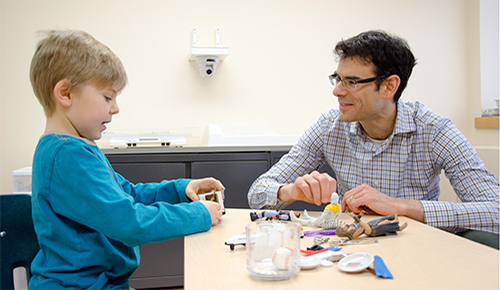
Breton Cameron (l) makes conversation with Lonnie Zwaigenbaum at the Glenrose Rehabilitation Hospital Research Centre.
A team across Canada, co-led by developmental pediatrician Lonnie Zwaigenbaum, is setting foot on a seven year journey to examine how attention influences emotion regulation in children with autism. Using new technology, the team wants to know if they can directly teach attention control to help prevent some of the risk of autism. They are also looking to learn how parents want information shared when there is a concern their child may have early signs of autism.
Susan Bryson, a clinical and developmental psychologist from Dalhousie University, is also co-leading the project, together with eight network investigators across Canada from disciplines including child psychology, child psychiatry, and electrical engineering. The seven-year research program began in July 2015 and is funded by a CIHR Foundation Grant, and a grant from Brain Canada in partnership with the Azreili Foundation.
This research focuses on infants whose older sibling has autism. The children start participating at age six months and are followed to the age of five years.
"I think the project will tell us more about why some infants are more likely to develop autism. We hope it will give us practical information about what clinicians should watch for early in life, as well as better measurement tools. It's not out of the question that some of these technology-based measures might find their way into the clinic," says Zwaigenbaum.
New eye tracking technology will measure visual attention of the infants. A dynamic object will appear on a screen and a second interesting object will surface on the other side of the screen. Eye tracking will help Zwaigenbaum and his team assess where the child is looking and precisely measure the time it takes for the infant to move their attention to the second object.
Computer training will help the infants be more flexible in how they disengage attention, taking less time to shift from the first object to the second.
The team wants to see if the training will help the infants regulate their emotions, become more effective communicators and, ultimately, reduce their risk for autism. In previous research, they've found infants at risk get stuck looking at the first object with some of these same infants having trouble regulating their emotions. "There's something that is distressing about getting stuck and not being able to shift their gaze," says Zwaigenbaum.
Infants will also go through a series of sticky situations to assess their emotion regulation, like brushing their own hair or putting on a hat. Their behavioural reactions will be recorded and their heart rate will be monitored.
Emotional regulation and attention control will be measured from age six months to one year. As these children age, a scale will measure how the two factors affect their early communication skills like using eye gaze to direct another person's attention.
In a second study, infants showing early signs of autism will receive a 12-week intervention called the Social ABCs. Developed by Bryson and Jessica Brian, from the University of Toronto, the intervention helps advance how the kids communicate and regulate their emotions. Parents are highly involved in Social ABCs, finding learning opportunities in day-to-day activities.
Zwaigenbaum's team will also interview parents about how they would like information shared when there is a concern their child has early signs of autism. They want to learn what conversations are acceptable for parents so their kids get diagnosed and supported as early and effectively as possible.
"If we learn how to better communicate with parents and work more effectively with them in a partnership, maybe that will also provide some guidance for clinical practice," said Zwaigenbaum.